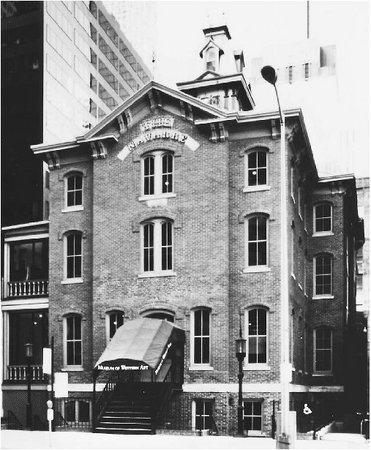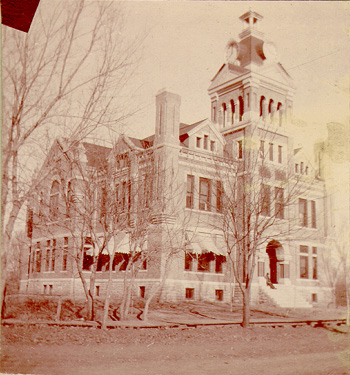
Miami County Courthouse - Paola, Kansas
"My Dear Sweetheart: I am becoming desperate. You must arrange a meeting. True love cannot be trifled with in this fashion. You know my love for you and I cannot stand this thing much longer. People have been killed for less, and more may follow. Don’t get the idea this is a threat, or that I mean it that way, because it is the real thing. Be true to me. I love you."
YOUR OWN SWEETHEART”
On June 10, 1912, before news of the tragedy in Villisca had spread, a three and a half page letter was discovered on the stairway leading to the local Justice of the Peace’s office. The quote above is taken from the memory of a Judge who read it and once Sheriff Chandler had it in his possession he turned it over to a Kansas City detective. I have never seen the letter in its entirety and as far as I know it is lost to time. The opinion of those who saw it was the writer was uneducated and the letter rambled incoherently for most of its length. The section above is a “recreation” written by the newspaper so it cannot be adequately analyzed for authenticity. The one thing that strikes me as odd is the lack of names. Not just by the writer but the salutation. I would expect, at the very least, the use of pet names. Contrast the letter above with the one below left by Rollin before leaving Anna on May 31st.
"Anna,
Well, I am going to K.C. Leave my clothes and those too (sic) pictures with Charley. I will be back next faul (sic) and get them. You will not be bothered with me eny (sic) more. Good-bye. ROLLIN"
Even in a rage strong enough to simply pick up and leave (he’d done it before so maybe the rage wasn’t all that strong), Rollin addressed the note to Anna and signed his name. The use of the word “sweetheart” as a term of endearment was fairly generic, even in 1912. To use it twice in reference to different people is very unimaginative. The line “people have been killed for less, and more may follow” is ridiculously cryptic and written for effect. It’s the equivalent of writing in big red letters at the top of the page “THIS IS A DEATH THREAT FROM A MANIAC!”
So is this letter authentic? As it is printed above I would say no. But that is only one paragraph as remembered by a person who read the letter a couple of times. The actual letter of three and a half pages could very well have been real. If that is the case then how did the letter come to rest on those steps ninety-seven years ago? I suppose a curiosity seeker could have picked it up while touring the crime scene, in fact it could very well be what happened;
stranger things have been boosted from victim’s.



 Early in the morning of June 10th, 1913 Mr. Bagshaw was awakened by a tapping at his bedroom window. He looked out and saw his neighbor, Ida Keller. He opened the door and she told him an intruder had killed her husband and oldest child with an axe. She was carrying in her hand the bloody axe and a lantern. He allowed the woman to use his phone in order to call a doctor and she left, taking the axe and lantern with her. Neighbors arrived at the Keller house about ten minutes later and found Arthur Keller lying in bed gasping for breath, his skull smashed. Ida Keller was kneeling beside her seven year old daughter, Margaret, bathing her face. Arthur Keller died a few hours later and Margaret would die the following evening.
Early in the morning of June 10th, 1913 Mr. Bagshaw was awakened by a tapping at his bedroom window. He looked out and saw his neighbor, Ida Keller. He opened the door and she told him an intruder had killed her husband and oldest child with an axe. She was carrying in her hand the bloody axe and a lantern. He allowed the woman to use his phone in order to call a doctor and she left, taking the axe and lantern with her. Neighbors arrived at the Keller house about ten minutes later and found Arthur Keller lying in bed gasping for breath, his skull smashed. Ida Keller was kneeling beside her seven year old daughter, Margaret, bathing her face. Arthur Keller died a few hours later and Margaret would die the following evening. 



 Anatoly Onoprienko was dubbed the “Beast of Ukraine,” and killed entire families in remote villages of the Ukraine from 1989 to 1995. I bring him up because serial mass murder perpetrated by an individual is almost unheard of. Usually such actions are carried out by a group of people (The Manson Family), a government (Camir Rouge) or an ideological faction (Al Qaeda). When studying the Midwest Axe Man investigators don’t have much precedent to look at. What drives a person to not only kill an entire family but to actively seek families as their victims? In the case of Onoprienko it was revenge. Revenge for his father abandoning him to an orphanage; revenge for his mother dieing while he was a young boy and allowing his father to take the action he did. He would burn down the houses after killing the occupants because he didn’t want to just kill the family, he wanted to destroy it. To Anatoly the concept of a family was a cruel joke played on him by society.
Anatoly Onoprienko was dubbed the “Beast of Ukraine,” and killed entire families in remote villages of the Ukraine from 1989 to 1995. I bring him up because serial mass murder perpetrated by an individual is almost unheard of. Usually such actions are carried out by a group of people (The Manson Family), a government (Camir Rouge) or an ideological faction (Al Qaeda). When studying the Midwest Axe Man investigators don’t have much precedent to look at. What drives a person to not only kill an entire family but to actively seek families as their victims? In the case of Onoprienko it was revenge. Revenge for his father abandoning him to an orphanage; revenge for his mother dieing while he was a young boy and allowing his father to take the action he did. He would burn down the houses after killing the occupants because he didn’t want to just kill the family, he wanted to destroy it. To Anatoly the concept of a family was a cruel joke played on him by society.



 The trial of Charles Marzyck for the murders of Will Showman, wife Pauline and their three children, Lester, Fern and Fenton, was held in the Ellsworth County Court house after his arrest in Canada in April of 1912. Mr. Marzyck had no attorney, he choose to represent himself.
The trial of Charles Marzyck for the murders of Will Showman, wife Pauline and their three children, Lester, Fern and Fenton, was held in the Ellsworth County Court house after his arrest in Canada in April of 1912. Mr. Marzyck had no attorney, he choose to represent himself.



